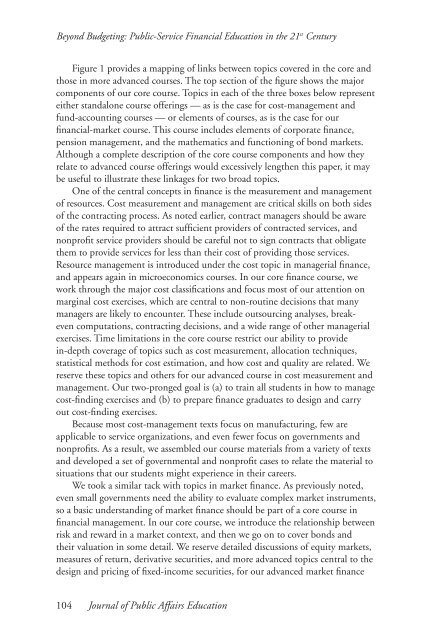Beyond Budgeting: Public-Service Financial Education in the 21st ...
Beyond Budgeting: Public-Service Financial Education in the 21st ...
Beyond Budgeting: Public-Service Financial Education in the 21st ...
You also want an ePaper? Increase the reach of your titles
YUMPU automatically turns print PDFs into web optimized ePapers that Google loves.
<strong>Beyond</strong> <strong>Budget<strong>in</strong>g</strong>: <strong>Public</strong>-<strong>Service</strong> <strong>F<strong>in</strong>ancial</strong> <strong>Education</strong> <strong>in</strong> <strong>the</strong> 21 st Century<br />
Figure 1 provides a mapp<strong>in</strong>g of l<strong>in</strong>ks between topics covered <strong>in</strong> <strong>the</strong> core and<br />
those <strong>in</strong> more advanced courses. The top section of <strong>the</strong> figure shows <strong>the</strong> major<br />
components of our core course. Topics <strong>in</strong> each of <strong>the</strong> three boxes below represent<br />
ei<strong>the</strong>r standalone course offer<strong>in</strong>gs — as is <strong>the</strong> case for cost-management and<br />
fund-account<strong>in</strong>g courses — or elements of courses, as is <strong>the</strong> case for our<br />
f<strong>in</strong>ancial-market course. This course <strong>in</strong>cludes elements of corporate f<strong>in</strong>ance,<br />
pension management, and <strong>the</strong> ma<strong>the</strong>matics and function<strong>in</strong>g of bond markets.<br />
Although a complete description of <strong>the</strong> core course components and how <strong>the</strong>y<br />
relate to advanced course offer<strong>in</strong>gs would excessively leng<strong>the</strong>n this paper, it may<br />
be useful to illustrate <strong>the</strong>se l<strong>in</strong>kages for two broad topics.<br />
One of <strong>the</strong> central concepts <strong>in</strong> f<strong>in</strong>ance is <strong>the</strong> measurement and management<br />
of resources. Cost measurement and management are critical skills on both sides<br />
of <strong>the</strong> contract<strong>in</strong>g process. As noted earlier, contract managers should be aware<br />
of <strong>the</strong> rates required to attract sufficient providers of contracted services, and<br />
nonprofit service providers should be careful not to sign contracts that obligate<br />
<strong>the</strong>m to provide services for less than <strong>the</strong>ir cost of provid<strong>in</strong>g those services.<br />
Resource management is <strong>in</strong>troduced under <strong>the</strong> cost topic <strong>in</strong> managerial f<strong>in</strong>ance,<br />
and appears aga<strong>in</strong> <strong>in</strong> microeconomics courses. In our core f<strong>in</strong>ance course, we<br />
work through <strong>the</strong> major cost classifications and focus most of our attention on<br />
marg<strong>in</strong>al cost exercises, which are central to non-rout<strong>in</strong>e decisions that many<br />
managers are likely to encounter. These <strong>in</strong>clude outsourc<strong>in</strong>g analyses, breakeven<br />
computations, contract<strong>in</strong>g decisions, and a wide range of o<strong>the</strong>r managerial<br />
exercises. Time limitations <strong>in</strong> <strong>the</strong> core course restrict our ability to provide<br />
<strong>in</strong>-depth coverage of topics such as cost measurement, allocation techniques,<br />
statistical methods for cost estimation, and how cost and quality are related. We<br />
reserve <strong>the</strong>se topics and o<strong>the</strong>rs for our advanced course <strong>in</strong> cost measurement and<br />
management. Our two-pronged goal is (a) to tra<strong>in</strong> all students <strong>in</strong> how to manage<br />
cost-f<strong>in</strong>d<strong>in</strong>g exercises and (b) to prepare f<strong>in</strong>ance graduates to design and carry<br />
out cost-f<strong>in</strong>d<strong>in</strong>g exercises.<br />
Because most cost-management texts focus on manufactur<strong>in</strong>g, few are<br />
applicable to service organizations, and even fewer focus on governments and<br />
nonprofits. As a result, we assembled our course materials from a variety of texts<br />
and developed a set of governmental and nonprofit cases to relate <strong>the</strong> material to<br />
situations that our students might experience <strong>in</strong> <strong>the</strong>ir careers.<br />
We took a similar tack with topics <strong>in</strong> market f<strong>in</strong>ance. As previously noted,<br />
even small governments need <strong>the</strong> ability to evaluate complex market <strong>in</strong>struments,<br />
so a basic understand<strong>in</strong>g of market f<strong>in</strong>ance should be part of a core course <strong>in</strong><br />
f<strong>in</strong>ancial management. In our core course, we <strong>in</strong>troduce <strong>the</strong> relationship between<br />
risk and reward <strong>in</strong> a market context, and <strong>the</strong>n we go on to cover bonds and<br />
<strong>the</strong>ir valuation <strong>in</strong> some detail. We reserve detailed discussions of equity markets,<br />
measures of return, derivative securities, and more advanced topics central to <strong>the</strong><br />
design and pric<strong>in</strong>g of fixed-<strong>in</strong>come securities, for our advanced market f<strong>in</strong>ance<br />
104 Journal of <strong>Public</strong> Affairs <strong>Education</strong>
















